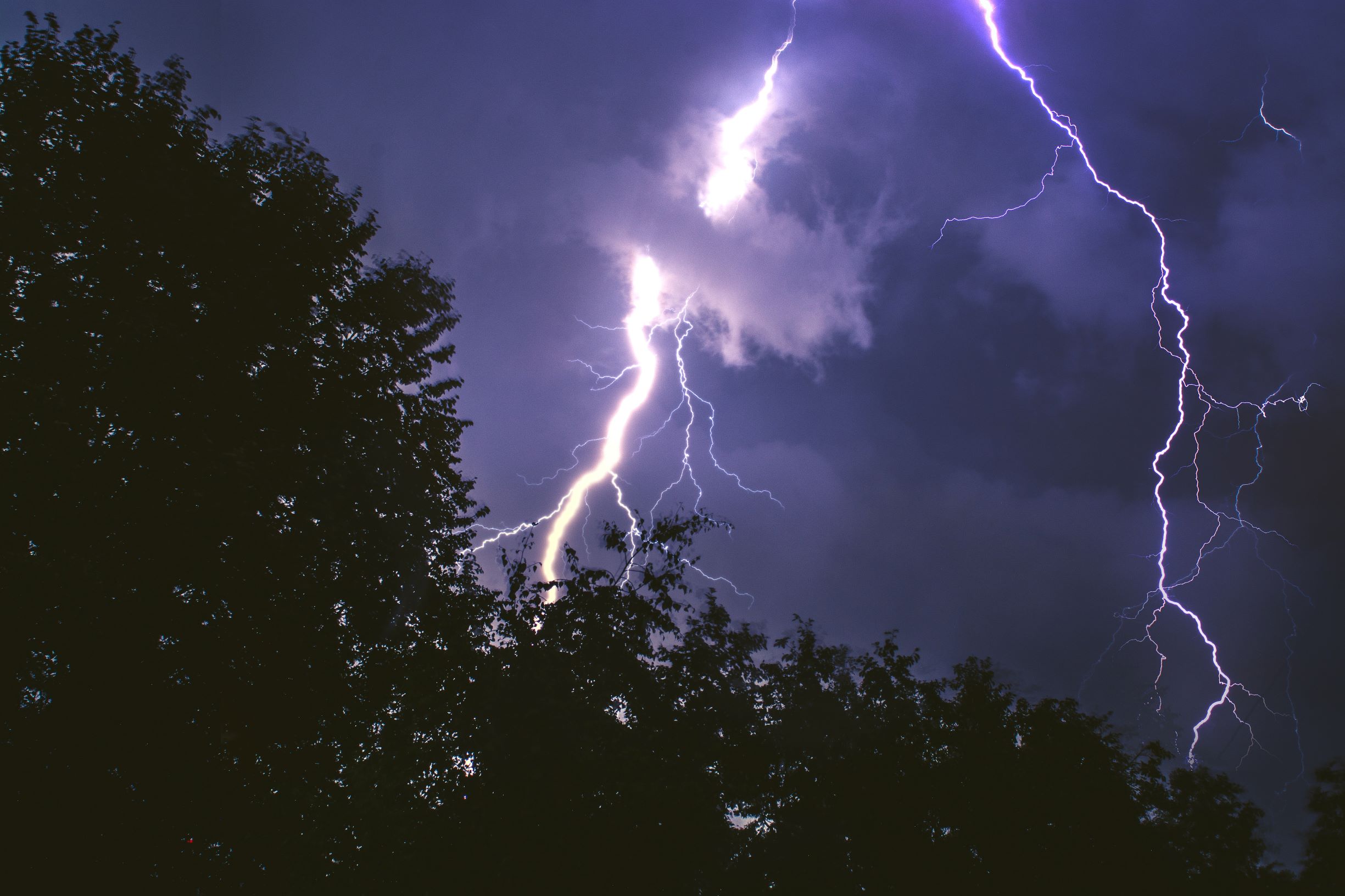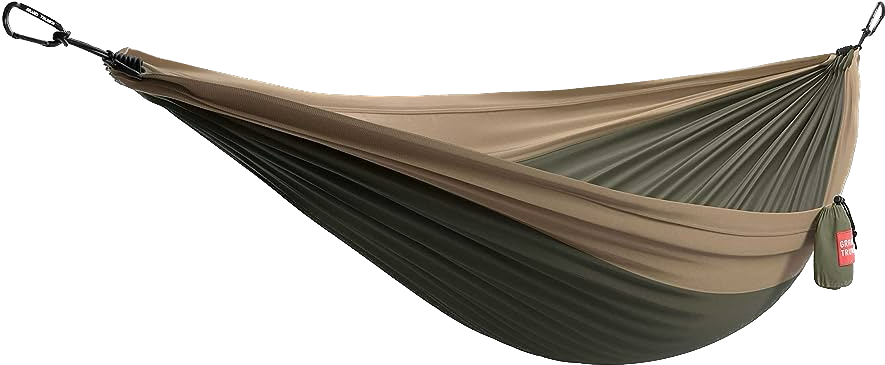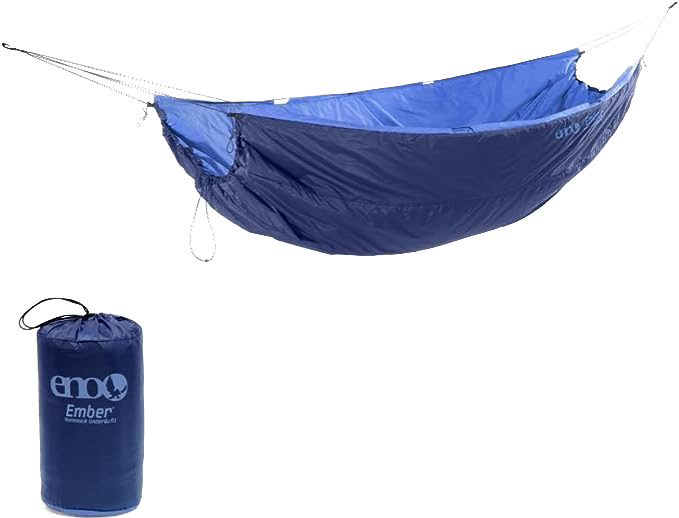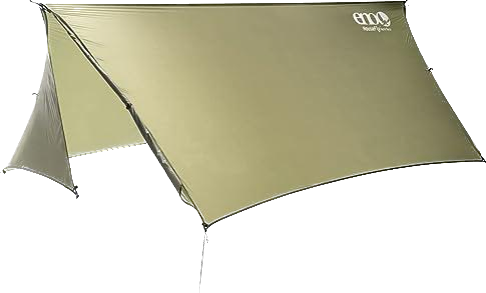Imagine this: you’re chilling in your hammock, swaying gently between two trees, when suddenly – *boom* – a thunderstorm rolls in. I don’t know about you, but the first thought in my head would be “Are hammocks safe in lightning storms?”. In this blog post, we’ll walk you through how to prepare, stay safe, and be comfortable while hammock camping in stormy weather. So buckle up folks, it’s about to get electrifying!
Hammocks are not inherently safe during lightning storms. Hammock materials are generally not good conductors. However, the trees you’re hanging from could act as natural lightning rods making hammocks unsafe. If you’re caught in a storm avoid open areas, metal objects, and bodies of water. Seek shelter in a sturdy structure or vehicle if possible.
Preparing for Hammock Camping in Stormy Weather

When going hammock camping, be sure to check the weather at your hammock location. This should be the first step and probably the most important whenever you decide to go on a hammocking trip. Outdoor goers get into trouble when they fail to plan ahead and make the proper preparations. Imagine not packing a rainfly only to end up in a bad storm or forgetting a blanket in cold weather. Knowing the weather, campsite conditions, and making a game plan before leaving could make the difference between a fun relaxing camping trip versus a miserable one in heavy rain.
Some argue tent camping is much easier and safer than hammock camping in a storm. They provide increased shelter from the elements and can be set up in safer areas away from tall objects like trees. If you’re worried about stormy weather on your trip, it might be worth packing a camp tent in the car just in case. You can check out our article on the safety breakdown between hammock vs tent camping. We go through what is overall safer on a camping trip.
Monitoring Weather Conditions
Check the local forecasts of the area you’re planning to visit. Before heading out, monitor your weather app and local forecast so as not to get caught off-guard by rain, strong winds, or even lightning. Thunderstorms often arrive in late afternoons and evenings – sometimes even unannounced or anticipated. I recommend being prepared for any sudden changes of plans due to unforeseen bad conditions outside.
Essential Gear for Stormy Weather
For those planning to go hammock camping in the midst of a storm, having suitable equipment is key for staying warm and dry. You’ll need an impermeable hammock, a tarp cover/rainfly, an underquilt, a sleeping pad, and a drip line – these essential items ensure you won’t get soaked during heavy rainfall!
I recommend spending extra on materials such as ripstop nylon or polyester. They’re both tough enough to endure rainy weather and perform better than cotton/canvas alternatives. Camping can still be fun when conditions are wet or if the weather forecast predicts bad weather. Remember, Preparation will go a long way to making an enjoyable and memorable outing trip, even if there’s rough weather brewing outside.
Emergency Plan
When out hammock camping, always have an emergency plan in place, especially when storms roll around. Plan ahead and make sure you can find shelter and stay warm (no one wants to sit in a soaked hammock in a rainstorm). If you start seeing lightning strikes or hear thunder, take refuge in a sturdy structure or vehicle until the storm blows over.
You should also bring some sort of communication device on hand- like a charged cell phone or battery-powered radio. This could help keep you informed if something unexpected occurs due to bad weather or phone for help while camping with your trusty hammock.
If you decide to bring along a dog with you to go hammock camping, you’ll want to take extra gear and precautions to ensure their safety and comfort. You can learn more in our article about hammocking with dogs.
Lightning Safety for Hammock Campers

If you are curious about the danger of being struck by lightning while camping in a hammock, rest assured that your chances per year are low, 1 in 960 000. But still, you should be cautious when using a hammock during stormy weather and strive to reduce the risk of being struck by lightning. As mentioned earlier, when setting up your hammock camp avoid open areas, mountain ridges, isolated trees or lone trees, and open water. These places make you and the places you’re hanging from the tallest object around – thus making your hammock an open target for lightning strikes.
Additionally, when setting up your hammock look for and avoid any dead trees or loose branches. If a heavy gust of wind comes in, branches or dead limbs could fall onto your hammock and harm you.
Avoiding High-Risk Areas
When it comes to hammock camping safety, location is key. Avoid mountaintops, valleys, or any other open terrain that could leave you vulnerable when lightning strikes if a storm rolls in– rather opt for an area with forests of uniform tree heights which can provide protection from the risk of being struck by lighting. Avoid using Metal trekking poles as anchor points for your hammock during thunderstorms since they can be a decent conductor of electricity.
Also, having tall trees around us isn’t desirable because we become what’s known as “the tallest thing around”! Remember: Lightning chooses the path least resistive so if careful consideration is given when selecting your spot then staying safe through those frightening weather conditions becomes more attainable.
Additionally, this could also mean avoiding areas with lots of animal traffic or game trails. If there’s a thunderstorm that comes through, you don’t want to be in the middle of a path where the wildlife will run through. Finding somewhere off the beaten path will help keep you safe from animals if a storm rolls in.
Proper Hammock Setup
The importance of properly setting up your hammock and gear cannot be understated. Especially if it starts to rain and you end up hammock camping in a thunderstorm. A hammock by itself offers little to no protection from the elements. However, there are several things you can do and set up to protect yourself against the elements and stay dry, warm, and safe.
Let’s dive into setting up your hammock. When setting up your hammock, find two trees and attach your anchors/straps. Ideally, you’ll want the straps to be about 5-7 feet above the ground. I recommend tying your straps from a tree trunk rather than a branch as they are going to be more strong and stable in carrying your weight. Tree trunks should be at least 8 inches in diameter to be considered safe to hammock from. If you’re using hammock straps, If you’re worried about encountering lightning, I recommend using straps made from a non-conductive material and storing metal parts away from the area where you will be hanging them.
After setting up your hammock, there are a few additional pieces of gear that you can use to enhance your experience – especially when there’s bad weather. If you’re preparing for being out in bad weather, I recommend the following:
- Rainfly
- Sleeping Pad
- Under Quilt
- Sleeping bag
- Drip Lines
- Ridgeline
Out of all the extra gear and add-ons, the rainfly will be your most important. If you suspect a rainstorm is headed your way, a rainfly is a must. Not only will they help keep you dry when it starts to rain, but also can help shield you from the wind.
Some rain flies are attached by a ridgeline or hammock suspension lines that are connected to the hammock, others are hung from surrounding trees and anchor points in the ground. Rainflies and tarps should be set up 1-2 feet directly above the hammock.
Having some of these gear pieces also help you feel more comfortable and sleep easier in the hammock. We’ve put together an article about sleeping safely while hammocking camping if you’re staying overnight and want to be safe and get a good night’s rest.
Seeking Shelter
In most storms, a rainfly, underquilt, and sleeping pad are more than enough to be safe, dry, and warm during a storm. However, if you’re hearing thunder nearby and you’re set up in an open, high-up spot, you should seek more protective shelter. Whether inside a fortified building or safely within your enclosed car with windows closed up tight, taking cover at one of these secure havens will be safest from a lightning strike.
Tarp Setup

Setting up a tarp or rain fly will give you a roof for your hammock and thus protection from the rain. If you set your tarp just a couple feet or two above the hammock the tarp can double as a wind blocker. The important thing when setting up a tarp over a hammock is to secure and tie down everything. Nothing is worse than sitting in your hammock and having your rain fly blow away in the middle of a rain storm.
Additionally, secure drip lines to make sure that any water flowing off of the tarp runs down toward the ground instead of getting into your bedding area. You’ll also need a waterproof rain fly so you can enjoy time in your hammock despite inclement weather conditions. Make sure to pick out an appropriate-sized tarp which should be at least 12 inches long or longer – this will ensure complete coverage for whatever type and size of hammock you are using.
Layering Clothing
When it comes to keeping warm during a hammock camping trip in cold weather, layering up is essential. Wearing layers can be likened to creating a human burrito – not only does this help keep body heat trapped and moisture wicking away from the skin, but also offers protection against strong winds or heavy rainfall. It’s important that you select fabrics suitable for each layer: lightweight materials should form the base. While thicker, insulating textiles are ideal for insulation purposes, ensure these two layers hug close enough together so that they trap heat efficiently! To avoid becoming overheated remember you can always start peeling off one layer at a time.
Drying Methods
Your hammock needs love, especially during the storms. When a storm rolls through, your hammock can get soaked. Don’t panic, after the weather has cleared up, there are some solutions to get your hammock back into its normal dry and cozy state.
This means drying out your hammock quickly. To start, you can take a towel and give it one final clean-up before drying. Once you’re ready to dry, try setting it aside in a sunny area or use a fan to help blow dry it. (By properly drying your hammock, you will ultimately lengthen the lifespan of your beloved camping buddy). Avoid leaving your hammock wet or damp as this can invite mold or mildew. If you have questions about if you can leave your hammock outside, check out our resource article that covers on if you can leave your hammock outside.
Summary
It doesn’t have to be daunting hammock camping during rain or lightning storms when you prepare and equip yourself with the right things. All that is needed for an enjoyable experience is monitoring conditions, getting your necessary gear ready, and rigging up a stable outdoor bed in your hammock correctly while also staying warm and dry – something any pro camper can easily do easily by following these tips! Ultimately, don’t let wet weather ruin what could otherwise be a pleasant journey – stay prepared no matter how unforgiving Mother Nature might become. Have happy safe camp trips!
Frequently Asked Questions
Is a hammock safe in a lightning storm?
It’s probably not the best idea to be lounging in your hammock during a storm – especially if there’s lightning, but if you’re feeling particularly daring, you can rest assured that with no metal parts or cords and being tied to two trees of uniform height, your hammock should be safe from lightning strikes. Simply put, avoid things that attract lightning.
Where is the safest place to go when there’s lightning?
If you ever find yourself stuck in an open field with a thunderstorm raging above, the best thing to do is look for the lowest and least exposed area. Get away from any structures that can conduct electricity such as tall trees or towers, this will decrease your chances of being struck by lightning.
Is it safe to sleep in a tent during thunder and lightning?
Staying in a tent during extreme weather is not wise as it won’t provide adequate protection from lightning and other rough conditions. If you are caught in a storm while camping, the best way to ensure safety is by seeking refuge inside a vehicle or building until the rough weather passes. For more questions about tent camping and lightning, we recommend checking out this article about how to protect yourself from lightning while camping from Tatonka.



 Hello there, we're Vira Outdoors!
Hello there, we're Vira Outdoors!

